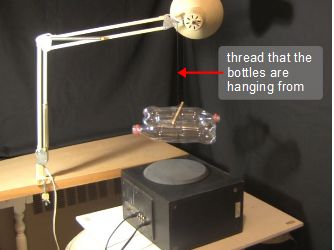Moving things with sound/Helmholtz resonance
It's easy to make two plastic bottles rotate around in a circle using just the bottles, some way to hang them and a speaker i.e. it's easy to do acoustic propulsion. This makes use of Helmholtz resonance (see the Helmholtz resonance video below) and some vortexing that happens at the opening of the bottles.


As the photos below show, I'd put an incense stick inside a bottle to fill it with smoke. I then took one photo with the speaker below it turned off and the other with it on. You can see the jet of air that propels the bottles when the speaker is on.


How to do it
The bottles are called Helmholtz resonators. As shown in the diagram below, to be a Helmholtz resonator the container must consist of a chamber (sometimes referred to as a cavity) and a neck with an opening in the neck. As you can see below, Christmas tree ornaments with the hook removed also meet this criteria. However, I couldn't get the ornaments to rotate because I couldn't raise the sound volume enough; it has to be around 120dB, around that of a jet engine. For the bottles the sound volume could be lower and so I had no problem making them move.


As well as enough sound volume, the frequency of the sound coming from the speaker has to be correct. This is called the resonant frequency and the thing going on in the bottle is Helmholtz resonance. The larger the resonator the lower the frequency. For my 710ml bottles the frequency was 173Hz (Hertz or cycles per second.) For my Christmas tree ornaments the frequency was 523Hz. The formula for the frequency is as follows:

Finding the correct frequency is easy; you've probably already done it at some time without knowing it. When you blow over the lip of a bottle, as in the photo below, a specific sound is made. That sound is different for different shaped bottles or containers, it has different frequencies (173Hz for the 710ml bottles, 523Hz for the ornaments.) Record the sound using a microphone, load the recording into a computer, and into some software like Audacity (Audacity is free) and examine the waveform to determine the frequency.


Then use the software to produce around 30 seconds or longer of sound at that frequency and play it on the speaker. Done!
Video - How to Move Things with Sound/Acoustic Propulsion
The following is my video showing the bottles being propelled, along with the smoke test showing the jet. It also shows how I recorded the sound, analysed it in software and produced a new file of the correct frequency.
Video - Why Blowing in Bottles Makes Sound and Helmholtz Resonance
This video explains Helmholtz resonance, or why the bottles make sounds when you blow across their opening. It then goes on to show that the speakers are doing the same thing, but at the right frequency to keep the bottles moving.
More topics
Renewable Energy
Science/Electronics
Projects
Build Van de Graaff
Wimshurst machine
Kelvin water dropper
Electroscope
Corona motors
Ball bearing motor
Crystal radios
AM Radio Transmitter
Fresnel lens
Electrets
Piezoelectric
Electrolytic capacitor
Joule thief
Peltier/Seebeck effect
Franklins bell
Can Stirling
Big Stirling
555 timer music
TEA laser
Laser diode fun
How Ion Prop. Works
Lifter/ionocraft
Star Trek Enterprise
Smoke precipitator
Moving with sound
Straw music instrumentsGravity light - DIY
Nitinol wire
Pyramid hologram
Arduino speech/Talkie
Arduino controlled Skull
Pinhole camera
Wireless electricity
Fly swatter powered CFL
Chlorophyll/fluorescence
Small SG Tesla coil
Photophone
Laser communicator
Hero's steam engine
Alcohol stove
Sunflower heat engine
BB-8 Droid
Ball cyclotron
Atmos. electricity
Photoelectric effect
Bottle rocket
Neural networks
Ornithopter
Curie temp. experiment
Lightning in bottle
Gyroscope - vinyl records
Raspberry Pi
Pi to Arduino
Pepper's ghost phone
Potato chip circuit
Ion wind rotor
LED flashlight
DIY coil gun
Electrolyzer
Zoetrope
Izzy - AI Robot
Resources
Power supplies
HV Probes/measuring
Miscellaneous
Efficiency & Conservation
Composting
Food
Non-conv. Energy
Non-conv. Propulsion
Space
Stories
